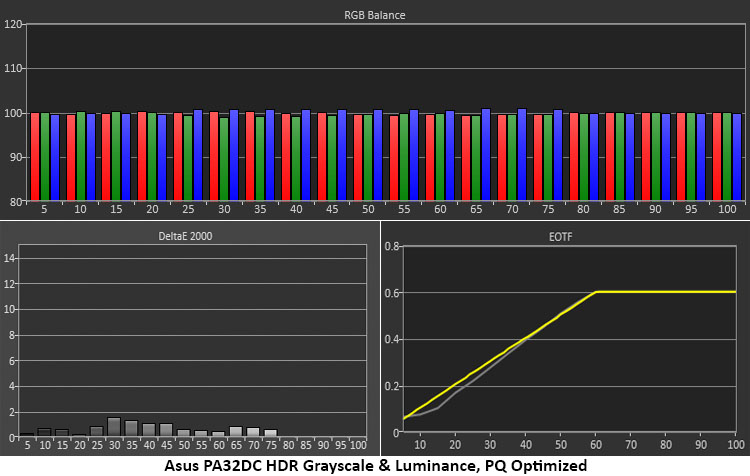Why you can trust Tom's Hardware
Our HDR benchmarking uses Portrait Displays’ Calman software. To learn about our HDR testing, see our breakdown of how we test PC monitors.
The PA32DC has HDR modes for every signal format in use today. HDR10, Hybrid Log Gamma (HLG) and Dolby Vision with EOTF and color choices for each where appropriate. The correct mode must be selected manually from the available options.
HDR Brightness and Contrast



OLEDs are not known for high brightness but the PA32DC exceeds its DisplayHDR 400 certification with over 528 nits peak. If you want to set the limit at 250 nits, that option is available in the OSD. Obviously, if you want greater light output, MiniLED is the answer, with the top two displays near or over 1,500 nits.
All the OLEDs deliver unmeasurable black levels, but MiniLED works well here with its large number of dimming zones. If one had never seen an OLED, the PA32UCX and XG321UG would be the pinnacle of image depth and contrast. With numbers like these, the PA32DC looks stunning with HDR content.
Grayscale, EOTF & Color



The PA32DC is color accurate by default in all its HDR modes. I went with PQ Optimized though the visual and measured difference between it and Clipped or Basic is barely perceivable. The white point had a few minor green errors at first, but I removed them with a few tweaks of the RGB Gain controls. My values are provided back on page one.
DCI-P3 color coverage is good, with just a slight under-saturation in red and hue errors in magenta. In Rec.2020 mode, the gamut most often used in HDR content, color is perfectly on hue and a tad over-saturated until the monitor runs out of color at around 85%. The second CIE chart is relevant to more content since that is the typical mastering standard. This is excellent performance.
MORE: Best Gaming Monitors
Get Tom's Hardware's best news and in-depth reviews, straight to your inbox.
MORE: How We Test PC Monitors
MORE: How to Buy a PC Monitor: A 2022 Guide
MORE: How to Choose the Best HDR Monitor

Christian Eberle is a Contributing Editor for Tom's Hardware US. He's a veteran reviewer of A/V equipment, specializing in monitors. Christian began his obsession with tech when he built his first PC in 1991, a 286 running DOS 3.0 at a blazing 12MHz. In 2006, he undertook training from the Imaging Science Foundation in video calibration and testing and thus started a passion for precise imaging that persists to this day. He is also a professional musician with a degree from the New England Conservatory as a classical bassoonist which he used to good effect as a performer with the West Point Army Band from 1987 to 2013. He enjoys watching movies and listening to high-end audio in his custom-built home theater and can be seen riding trails near his home on a race-ready ICE VTX recumbent trike. Christian enjoys the endless summer in Florida where he lives with his wife and Chihuahua and plays with orchestras around the state.
-
dk382 Reply
It's a professional mastering monitor, not meant for ordinary consumers... It's pretty cheap as far as those go, actually.Kridian said:$3,500!?
minimum $800. -
Kridian I don't think accurate color should be dangled out there like it's some golden carrot.Reply
f-that. -
drajitsh One of the problems of oleds was the burnout of the emitters, with the blue being the most vulnerable. Has that been solved.Reply -
dk382 Reply
Ordinary consumer displays tend to come reasonably well calibrated these days. This display takes things to the next level by having a built-in calibration system that costs quite a bit extra to include. Good, reliable, finely-calibrated tools come at a premium over standard consumer-oriented tools no matter the industry. And that's what this product is—a tool for professionals. This display and other displays like it (LG 32EP950 for instance) are being used as work-from-home HDR mastering monitors since they're cheaper and easier to use than dual-layer LCD mastering monitors (at the cost of lower peak brightness). It's also being used by colorists and graphic artists who demand perfect black levels.Kridian said:I don't think accurate color should be dangled out there like it's some golden carrot.
f-that.
drajitsh said:One of the problems of oleds was the burnout of the emitters, with the blue being the most vulnerable. Has that been solved.
No, not "solved," though it has been mitigated somewhat. They've developed various "pixel refresh" techniques that help the various colored subpixels burn at a more even rate. And this panel has a blank pixel buffer that the screen will move around in so static elements don't stay on the same pixel for too long.